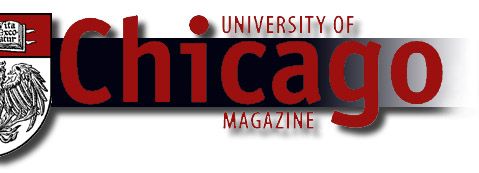|
Meanwhile, a few experiments are taking furtive stabs at a figure
for omega using still other methods. In one approach, several groups
of researchers have used the Hubble Space Telescope and ground-based
observatories to examine the red-shifts of far distant explosions
called Type Ia supernovae. Their measurements seem to show that
the Hubble expansion has not slowed appreciably over cosmological
time, suggesting that the universe will expand forever and has a
value of omega of approximately 0.8. Then again, by looking at X-ray-emitting
clusters of galaxies at different ages of the universe and comparing
the number density of those clusters, U of C graduate student Daniel
Reichert, working with Robert Nichol of Carnegie Mellon University,
has obtained a higher value for omega, perhaps as great as 1.
More reliable results should be obtained from steadily improving
measurements of the cosmic background anisotropy. While COBE has
mapped the cosmic background across the entire sky with an angular
resolution of 7 degrees, and ground-based and balloon-borne instruments
are mapping small swaths at 1- degree resolution, a definitive answer
to omega awaits the first years of the next millennium. Then, a
$70-million NASA satellite mission called MAP, for Microwave Anisotropy
Probe, will sweep out the sky with a beam of 0.2 degree.
Stephan Meyer, an associate professor of astronomy and astrophysics
at Chicago, is an experimentalist who was part of the COBE satellite
mission and is on the MAP team as well. The detectors on MAP, Meyer
explains, are not the most sensitive. But the probe will have an
advantage by virtue of the place from which it will view the sky.
After launch in August 2000, MAP will take three months to fly to
a spot known as L2, the second Lagrange point. L2 is on the Earth-sun
line, but outside Earth’s orbit. The satellite will keep perfect
time with the Earth as it orbits the sun, keeping its backside toward
both. On the side away from the sun, Meyer explains, the optics
will cool to some 60 or 70 kelvin and not change temperature at
all. That thermal stability is the key to precise measurement, Meyer
says.
The antennas will sweep the sky in a searchlight pattern that “kind
of looks like a spirograph between an inner and outer circle,” Meyer
says. The outer circle is 180 degrees, so MAP will look at half
of the sky, except for the piece right in the middle. “The whole
pattern gets repeated every hour or hour and a half, during which
we’ve only seen about 40 percent of the sky,” Meyer says. But because
the Earth is moving around the sun, the center blind spot sweeps
around, so that in a year MAP will see the whole sky.
Even the prospect of MAP’s results has Michael Turner almost dancing
on air: “By measuring the tiny 10-microkelvin variations in the
temperature, we’ll be able to determine omega. That’s just mind-boggling.
It’s been so hard weighing the universe, and all I can tell you
is that there’s more than 20 percent of critical density. All of
a sudden, we’re going to get [omega] to within 1 percent.”
Yet another probe, a project of the European Space Agency called
Planck, is planned for launch five years after MAP. It will boast
a beam width of only 0.1 degree. Meyer, who is helping develop the
detectors for Planck, says the probe will take measurements at several
frequencies to remove interference from the galaxy’s dust emission.
“Planck is a much more complicated satellite,” than MAP, he adds,
“costing easily five times as much, to do the ultimate experiment.”
MAP is very “aimed” at the cold dark matter picture, Meyer says.
“If it turns out that the cold dark matter picture is right and
everything fits in perfectly, then MAP will have made the important
discoveries,” he says. With a scientist’s skepticism, he adds, “I’m
guessing that’s just not so. And if MAP doesn’t prove the existence
of cold dark matter, Meyer notes, it will not be able to specifically
finger any of the other models.
“I believe MAP will fly,” Meyer continues. “It will answer the
burning questions of the moment, but it will pose a whole new set.
Planck is going to be poised, five years later, just perfectly—we
will have digested the questions of MAP, and Planck will be stepping
in to answer those.”
If definitive satellite results—from either MAP or Planck—indicate
that omega does equal 1, can the cosmologists just go home? The
nature of cosmic inflation virtually insures that the universe will
then be even more rich with possibilities than it is now. “If you
prove inflation takes place, I think you make a very strong case
that there is no beginning, there is no end,” Turner says, “for
the following reason: What we call the Big Bang is just the beginning
of our inflationary patch or region. It’s just when it took off.
And if inflation took place once, it probably is taking place constantly—not
in our neck of the woods, but somewhere. And it could well be that
these regions that inflate develop very differently—as differently
as you can possibly imagine. It could be that they have different
numbers of spatial dimensions, or that they have different realizations
of the laws of physics.”
Meyer too believes that even a conclusive value for omega may not
foretell an ultimate fate. “How do we know that there isn’t a larger-scale
force than gravity?” he asks. “Suppose you lived in a universe hot
enough to be generating nuclei. You wouldn’t know about gravity,
because it’s so weak at nuclear scales. You form the light elements,
and that’s it,” he says. “You would be unaware of the existence
of any force that could change them. You would despair that the
nuclei are stable, and you don’t know the best is yet to come: You’ll
form stars, galaxies, clusters, planets, and, by God, people. You
could not predict people if you did not know about gravity,” he
observes. After all, it takes gravity to make stars, and stars to
make carbon.
And if the little nuclear guy could not see gravity, Meyer asks,
“how can we be sure we have yet seen all the scales of structure
and the dominant force of the universe? How do we know there isn’t
something to come, that will follow what we perceive as a cold death?
We should be careful not to be smug—the answer may lie beyond.”
|



